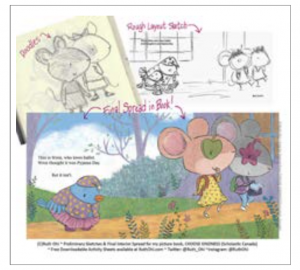Meeting Canadian Writers and Illustrators of Children’s Books
What inspires the writers of the books your students read? How does an illustrator decide what to draw? Is it true that most authors and illustrators don’t know each other? This column features a different Canadian children’s book creator in each issue and shows you the story beyond the covers.

60 books illustrated! Did you always know that you wanted to be an illustrator? What made you “get into” books for children?
I feel very fortunate that I’ve gotten the chance to do what I love for a living for over thirty years. I’m grateful to all the publishers who see possibility in my stories, and the teachers and librarians who have shared my books in their classrooms and libraries. Without them, I would not have this career.
My parents encouraged me to follow my dreams. They offered the chance to pursue whatever I was passionate about at the time. I’ve always loved picture books. I like to show kids my grade school autobiography, where I wrote “in the future I would like to be an illustrator of children’s books or a teacher” to demonstrate that what they’re thinking now as a young person matters, that dreams can come true. I did get sidetracked on the way, though, with my love of wildlife and nature: I also wanted to be a marine biologist or a forest ranger!
You studied at the Ontario College of Art. Did this open your eyes to many different techniques?
Definitely. Being exposed to so many facets of the art world and being taught by those who work in it was hugely beneficial in kickstarting my career while contributing to a solid foundation for the long term. I was lucky to get my first commissioned book from Annick Press soon after graduating and have since published about a book a year.
Has your own style developed and evolved or was it always there? Is it still changing?
My newest book, Choose Kindness, is the result of experimenting with layering colour and textures (watercolour and coloured pencil using digital tools). I think each new project offers a chance to try something new. Japan’s 2011 tsunami driven story, Kenta and The Big Wave, suited soft graphite and watercolour, Scribble incorporated mixed media collage, while No Help Wanted! is pencil based. The Fox and Squirrel Series uses black ink and watercolour. I’m currently enjoying learning more about digital tools like Photoshop.
Where do ideas come from for you?
Every story comes from an emotional response, a tugging of the heart—sad, happy, hopeful, frustrated. The ideas often evolve from personal experiences. I’m a second and third-generation Japanese Canadian and was often the only Asian in my class. Scribble (Scholastic Canada) is a shapes story that celebrates our differences and what can be accomplished when using those differences in harmony. Fox And Squirrel (Scholastic Canada) celebrates our similarities. The two main characters are very different in so many ways, but find that they have enough in common to get along.
Once you have an idea, what is the general process? How long does it take until you have the book in your hands?
This past Spring I was putting together materials for my fall Choose Kindness presentations and found a manuscript dated ten years ago. A typed manuscript happens after many journal jottings and notebook sketches, so my guess is that this book took over ten years to gestate. Once a manuscript or book dummy (a mini, rough illustrated version of the book) is accepted by the publisher, I like at least six months to do final art. Here are some working sketches that led to a final spread for Choose Kindness.
You have written your own texts as well as illustrated stories by other authors. Is there one way you prefer over another? How are they different?
I’ve had the privilege of illustrating for some incredible authors like Hazel Hutchins, Joy Kogawa, and, most recently, Ted Staunton’s Friends For Real (Scholastic Canada). I enjoy being both an author/illustrator and illustrator. Working with someone else’s story offers the chance to delve into someone else’s world, which can be fascinating.
What do you do during an author visit to schools? And how have online school presentations changed what or how you share with kids?
One of my favourite parts of the job is working with young people—virtually or in person. Getting kids excited about reading, about their own words and pictures, helping them realize that their own lives are full of interesting characters and stories is incredibly rewarding.
My sessions can be geared towards JK – Grade 3. I also have a cartooning virtual session for grades 4/5. Kindergarten sessions are usually 20 to 30 minutes, with the 1 – 3s having 30 to 40 minutes depending on questions. In Person visits may include where ideas can come from, an author/illustrator’s life, how a book is made, Q & A and an interactive drawing demo and hands-on segment. Virtual visits have much of the same content and energy as my In Person. Props that would otherwise be too fragile or cumbersome to bring to an In Person are easy to share online. Virtual Draw-Alongs all happen up close—everyone has a front row seat!
Tell us about your next book!
I am incredibly excited for July 2021’s Choose Kindness (Scholastic Canada) which is populated by a rabbit from my backyard and various other animal faves that I’ve encountered in Canada. It’s about how one act of kindness can start a chain reaction of the best kind and not only make someone else’s day better, but improve one’s own day at the same time. The verb “choose” was a very conscious choice for the title.
For more details on Ruth Ohi’s books and school presentations, check out: ruthohi.com
Margriet Ruurs
Margriet Ruurs is the author of over 40 books for children and conducts (ZOOM) school presentations: margrietruurs.com
Enjoy her travel-and-books blog here: globetrottingbooklovers.com
This article is featured in Canadian Teacher Magazine’s Fall 2021 issue.

